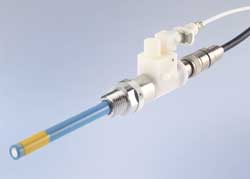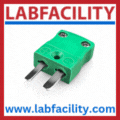
Posted to News on 19th Sep 2010, 21:43
Enamel-coated pH sensors offer advantages over glass types
The monitoring of the pH of liquid media in high-end hygienic processes - in biotechnology, pharmaceutical and food processing - ensures not only that legal requirements are met, but also that quality standards are maintained, thereby reducing cost and ensuring optimum yields.

In these high-end processes, the life of the pH sensor is a tough one; typically it has to withstand cleaning with acids and caustic solutions under high temperatures, as well as steam purification. This would not be a problem but for the fact that most pH measurement is carried out using glass electrode pairs.
Glass is vulnerable to both physical damage and chemical attack; strong acids and strong alkaline solutions attack the glass membrane of pH sensors, and even neutral solutions containing high concentrations of alkali ions - sodium ions, in particular - also assault the glass. Adding to these problems, the vulnerability of glass to chemical attack increases with temperature. For every 30degC rise in temperature, the rate of attack increases ten-fold. Consequently, electrode life is reduced when the pH sensor is used in process solutions at elevated temperatures, or when the glass formulation of the sensor is inappropriate for the sensed medium.
Glass systems also need special care against the effects of dehydration. Left out of solution, a pH glass membrane will gradually dehydrate, which can affect its performance; the sensor will have slower response and a higher than normal impedance when put back into operation.
Dehydration can also affect the operation of the reference electrode in glass systems, preventing proper operation. The electrolyte can leach out of the electrode cavity, through the junction(s), forming salt crystals on the junction surface. Over time the leaching weakens the electrolyte potential and may cause a phenomenon known as a 'bridging effect'.
Both of these conditions will increase the output impedance, making the output of the reference electrode unstable. Moreover, with continued dehydration the impedance will rise to a level that renders the pH meter unusable.
Enamel-coated pH sensors
The limitations and special requirements of glass-based pH systems, have led to the development of a new generation of pH sensors manufactured from stainless steel and coated with enamel. Compared with conventional glass electrodes, enamel-coated sensors offer a number of major operating benefits. First, they are largely unbreakable and, consequently, less susceptible to errors in production. Second, they can be cleaned in place (CIP), saving users both time and cost by removing the requirement for sensor removal, cleaning and recalibration. Third, the sensor can be left dry for extended periods - for as long as the user requires - without any drying out or loss of performance. Fourth, the enameled finish provides high levels of non-stick performance for high hygiene while pH values are measured - and it can be used in media with a high proportion of solid particles. Fifth, the sensors require recalibration only once or twice a year; maintenance is limited to the yearly exchange of the reference electrolyte supply bottle. Six, the sensors have no moving parts or additional electric or pneumatic actuators, so the complexity of central process control is reduced.
The ability of enamel ph sensors to allow CIP is critical, as sterility is key in ensuring that biochemical reactions can proceed cleanly, with maximised sterility and with no effects on the end product. In contrast, opening up of the process, as was the case with glass sensors, where sensors had to be removed via special automated armatures and cleaned separately with chemicals before being recalibrated, risked bringing germs or contamination into the process.
Burkert's new Type 8201 measuring system represents the latest generation in enamel pH sensors. The system has a 'fit-and-forget' design that enables its sensor to stay in process, even during CIP purification.
The hygienic design and robust, glass-free construction of the 8201pH sensor mean that the unit is particularly suitable for use in high-end hygienic processes; for example, in the production of foods and active ingredients where the pH value of liquid mediums - including those which are viscous or contain solids - is measured.
In addition, the 8201 provides a long service life in these processes and high levels of accuracy, with its ability to measure absolute pH values between 0 and 12 at medium temperatures up to 140degC, and process pressures up to 6bar.
Described as easy-to-use, the 8201 pH sensor is a highly integrated device, operating as a single-rod measuring cell with the measuring electrode and reference electrode combined in one element. The sensor probe is a stainless steel tube, which also houses a Pt 1000 sensor for temperature compensation. It is coated with an ion-sensitive enamel layer, providing an extremely smooth surface that prevents media from sticking during measurement, thereby making the sensor very easy to clean.
Unlike many glass probes that have electrolytes that dry out in air, the 8201 sensor can be left dry for extended periods without any drying out or loss of performance. The electrolyte is stored in a separate electrolyte vessel and permanently connected to the electrode via a hose. The pressure of the electrolyte vessel is maintained slightly above process pressure by means of an attached pressure controller.
Fluid Control Centre
1 Bridge End
GL7 1QY
UNITED KINGDOM
+44 (0)1285 648720




